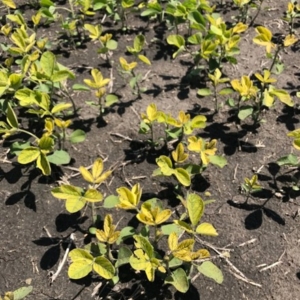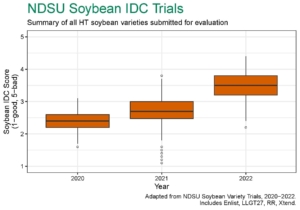Are Soybean Iron Deficiency Chlorosis (IDC) Ratings Getting Worse?
This article originally appeared in the AGVISE Laboratories Spring 2023 Newsletter
For the past three years, we have seen severe and widespread soybean iron deficiency chlorosis (IDC) symptoms across the region. In fact, some seasoned agronomists have commented that 2022 was the worst soybean IDC year that they had experienced in decades. Soybean IDC is a serious risk on soils with high calcium carbonate or salinity, which interfere with iron uptake and utilization in soybean. With all that we have learned about soybean IDC risk and management over the past 30 years, we have to ask, “What is going on? Why is soybean IDC continuing to get worse?”
The NDSU soybean IDC trial data suggests it might be the soybean varieties. Each year, seed companies submit soybean varieties to NDSU for independent evaluation of soybean IDC ratings (https://www.ag.ndsu.edu/varietytrials/). The NDSU trial sites impose high soybean IDC risk, where the best and worst soybean varieties are thoroughly tested alike for soybean IDC tolerance. In recent years, the problem is that the year-after-year average soybean IDC rating continues to get worse (see figure). In 2022, the average soybean variety scored 3.5 on the NDSU scale (1-good, 5-bad). Adverse soil and weather conditions may explain part of the worsening problem in the NDSU trials, but it is apparent that few soybean varieties can handle severe soybean IDC on their own. In defense of soybean breeders, there are a lot of different breeding objectives on their plates right now, including herbicide tolerance packages, disease and insect pests, and seed yield, of course!
This means we need to revisit and use all of our options in the soybean IDC toolbox. We have known about these effective management tools for over 20 years, and we are going to need to use all of them until soybean variety IDC tolerance can get to where we need it.
Steps to better soybean IDC management
- Soil test each field, zone, or grid for carbonate and salinity to evaluate soybean IDC risk potential.
- Plant soybean in fields with low soybean IDC risk. Choose a tolerant soybean variety, if you can. Some high IDC-risk fields may not be suitable for soybean.
- Use a chelated iron fertilizer (high-quality EDDHA or HBED chelate) with seed at planting. Liquid and dry products are now available.
- Plant soybean in wider rows. Soybean IDC tends to be less severe in wider rows.

